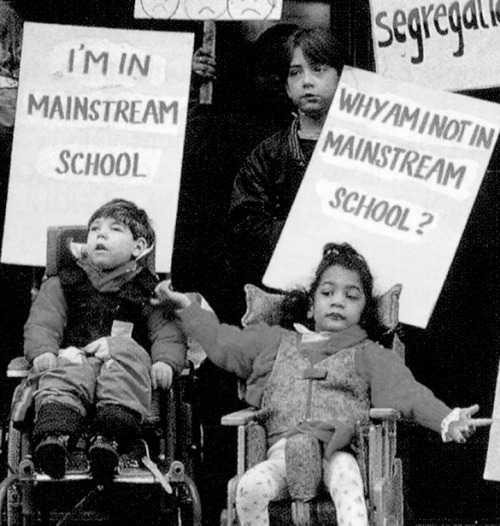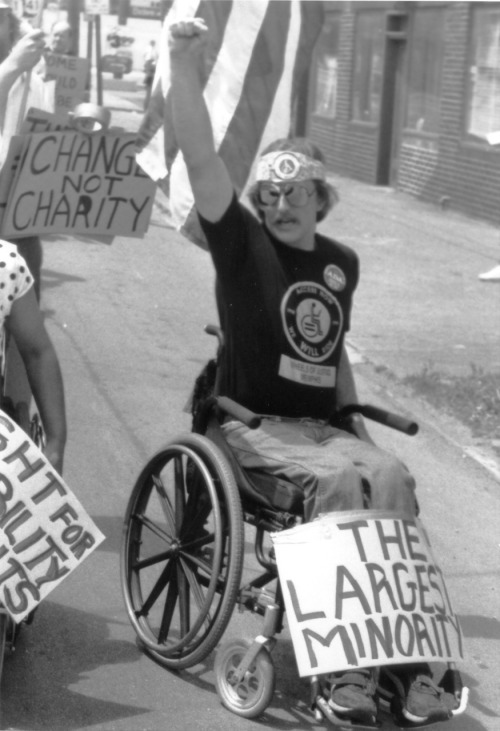twofingerswhiskey: i-eat-bread-and-cry-on-the-floor: anarchist-accessibility:aegipan-omnicorn:jenn
twofingerswhiskey: i-eat-bread-and-cry-on-the-floor: anarchist-accessibility:aegipan-omnicorn: jenniferrpovey: aegipan-omnicorn: somekindaspacecadet: littleredspaces: theperksofbeingdisabled: Vintage on disability rights. Don’t let the black and white trick you. The Capitol Crawl was in 1990. This is not ancient history. This was in 1990. Also: these photos were not taken by anonymous people – They are all the work of Tom Olin, who has dedicated his career to documenting the Disability Rights movement. Thank you for the credit and addition! It’s important for people in the margins to name each other – not let ourselves become anonymized by those in power. [Image Description: A series of six photographs. Image 1: A grey-scale photograph of a crowd of protestors marching down a road. The majority of the crowd are in wheelchairs. One person is carrying an American flag.Image 2: A poster depicting a disabled symbol on a dime. There is text above and below the image that says, “You Gave Us Your Dimes / Now We Want Our Rights.”Image 3: A photograph of two protestors. The two protestors are children in large wheelchairs. The first kid is a young, light-skinned boy. He is wearing a coat and looking off camera. He is sitting in a full wheelchair. Behind the boy is a sign that says, “I’m in Mainstream School.” The second kid is a young, tan girl. She is wearing a coat and looking off camera with her arms raised. Behind her is a sign that says, “Why am I not in Mainstream School?”Image 4: A photograph of a low shot of the stairs to the Capitol building. There are two people crawling up the steps. Image 5: A photograph of a light-skinned person in a wheelchair. They are raising their fist as they march down the road with the other protestors. They are holding a sign that says, “The Largest Minority.” Behind them are signs that say, “Change Not Charity.”Image 6: A group photograph of a high shot of the crowd of marchers. Most of the crowd is in wheelchairs. They are all looking up at the camera. Some have their fists raised. Some people are kneeling. They are holding up a sign. The text is out of focus, but a disabled symbol is visible. /End ID] Here’s some more photos in color!!! B&W images are used to separate us from history and create a disconnect. This was 30 years ago–there were plenty of in-color cameras available, yet these were some of the only easy pictures to find. b&w is not used to separate anything, BUT “do you know how expensive colour film was” is ALSO not an argument. the reason for these photos being b&w is not sinister or deliberate, at least not deliberate in the way you thinkprint journalism, such as newspapers and weeklies, was not taken seriously if you used colour film. it was seen as the stuff of amateur home photos, of children’s birthdays and trips abroad. of portraits taken too high up and a bit further away than you’d like of relatives who died a week after it was taken. (that last bit is paraphrased from a book i read on the topic)the only exception was national geographic and magazines but often those were seen as much more casual fare - the type of thing you bought at a checkout to flip through as your hair dried or as you smoked your pipe tobacco and relaxed. nat geo was serious, at times, but often it used colour to grab attention more than illustrate a mental image. colour is fine, but not “journalistic.”black and white was seen as Serious and Important. colour was not! using good film stock and calling in journalists and asking favours of photographers with big newspapers is how they got the story published at all.don’t see malice where there is none. there was real, tangible pain and desperation to be heard. and black and white did that impactfully for the time and we still have these images circulating now, which says something about how well that worked. -- source link
Tumblr Blog : perksofbeingdisabled.tumblr.com





